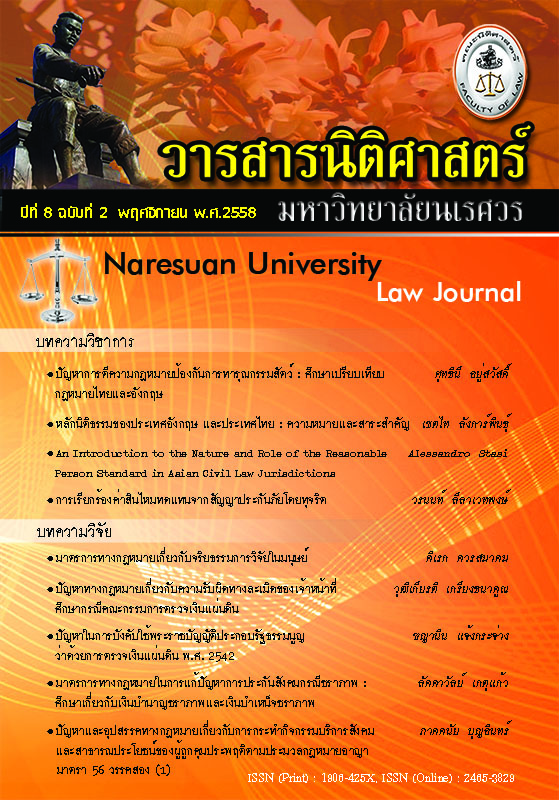An Introduction to the Nature and Role of the Reasonable Person Standard in Asian Civil Law Jurisdictions
Main Article Content
Abstract
The reasonable person is a legal fiction of normative appeal that plays an important role in many different areas of private law, public law and criminal law. Such standard is present in both contract and tort law. In the area of contract law, it can be used to determine contractual intent, breach of the standard of care or fairness of terms and conditions. In tort law, the reasonable person standard is applied to assess possible negligence. The reasonable person standard is based on the broader concept of reasonableness, which is used to derive various open ended legal expressions. Even though terms such as reasonable doubt, reasonable decision-making and reasonable care have different meanings, the concept of reasonableness acts as a common thread linking these instances of use. This paper attempts to convey an understanding of the reasonable person standard as it is applied in the civil law systems of Asian countries: who is the reasonable person and how can the reasonableness or “prudence” of his/her conduct be analyzed? After addressing these issues, the paper will analyze the application of the reasonable person standard in contract law and tort law of Asian civil law jurisdictions with a special focus on the legislation of Thailand, Japan, and the Philippines.
Article Details
References
Bohlen, F. “The Probable or the Natural Consequence as the Test of Liability in Negligence.” American Law Register. 49, no.3 (1901): 148-164.
Bongiovanni, G., Sartor, G., and Valentini, C. Reasonableness and law. Dordrecht: Springer, 2009.
Byrden, P. In Search of the Reasonable Person in Canadian Law – Are We Asking the Wrong Question. 24th Annual Conference of the Council of Canadian Administrative Tribunals, Ottawa, (June 25-27 2008).
Craig, P. The Nature of Reasonableness Review. Current Legal Problems. 131, (2013): 140-172.
Daly, P. “Wednesbury’s Reason and Structure.” Public law, ฉ.2 (2011): 238-259.
Deffains, B. and Kirat, T. Law and Economics in Civil Law Countries. Amsterdam: Jai, 2001.
DiMatteo, L. A. “The Counterpoise of Contracts: The Reasonable Person Standard and the Subjectivity of Judgment.” South Carolina Law Review. 48, (1997): 293-355.
Donovan, A. and Wildman S. “Is the Reasonable Man Obsolete? A Critical Perspective on Self-Defense and Provocation.” Loyola Law Review. 14, (1981): 435-458.
Fletcher, G. P. “The Right and the Reasonable.” Harward law Review. 98, no.5 (1985): 949-982.
Gilles, S. G. “On Determining Negligence: Hand Formula Balancing, the Reasonable Person Standard, and the Jury.” Vanderbilt Law Review. 54, no.3 (2001): 813-861.
Hickman, T. Public Law After the Human Rights act. Bloomsbury Publishing, 2010.
Kamol, S. The Civil and Commercial Code Books I-VI and Glossary. Bangkok: Nitibannakan, 2008.
Kelman, M. A guide to critical legal studies. Cambridge. MA: Harvard University Press, 1987.
MacCromick, N. “Reasonableness and Objectivity.” Notre Dame Law Review. 74, no.5 (1999): 1575-1604.
Miller, A. D. and Perry, R. “The Reasonable Person.” New York University Law Review. 87, no.2 (2012): 323-387.
Moran M. “The Reasonable Person: A Conceptual Biography in Comparative Perspective.” Lewis & Clark Law Review. 14, (2010): 1233-1283.
Tingle, J. “Establishing Breach of the Duty of Care in the Tort of Negligence.” British Journal of Nursing. 11, no.17 (2002): 1128-1130.
Zipursky, B. C. “Sleight of Hand.” William and Mary Law Review. 48, (2007): 1999–2041.
Wade, W., Forsyth, C. and Hare, I. The Golden Metwand and the Crooked Cord: Essays on Public Law in Honour of Sir William Wade QC. Oxford: Oxford University Press, 1998.


